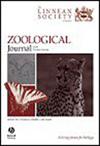从坎贝琥珀中发现的蜉蝣(蜉蝣目:蜉蝣科)的第一个记录表明在始新世早期的印度存在冈瓦纳蜉蝣群
IF 2.8
2区 生物学
Q1 ZOOLOGY
引用次数: 0
摘要
早始新世印度坎贝琥珀中的昆虫包裹体代表了印度板块在与亚洲碰撞之前漂移的动物群,这导致了喜马拉雅山脉的隆起。尽管印度代表了冈瓦纳的一个片段,但在坎贝琥珀中几乎没有冈瓦纳的类群。造成这种现象的原因,一方面是由于广泛的火山活动引发了印度板块上的物种灭绝,另一方面,次大陆与邻近大陆的相对接近,这促进了早在印度向北航行期间的动物交换。本文报道了在Cambay琥珀中发现的第一个蜉蝣化石,其中包括两具雄性蜉蝣化石,属于轻蝇科,Atalophleboculata分支。我们将其中一个研究标本描述为Aikahika veta gen. et sp. 11 .这个记录代表了Atalophleboculata最古老的明确存在,在它最有可能起源的前冈瓦纳(Gondwana)碎片中达到了最高的现存多样性。因此,本文报道的蜉蝣化石可能是漂移的印度板块上为数不多的冈瓦纳化石之一。本文章由计算机程序翻译,如有差异,请以英文原文为准。
The first record of mayflies (Ephemeroptera: Leptophlebiidae) from Cambay amber suggests a Gondwanan mayfly fauna in Early Eocene India
Insect inclusions in Early Eocene Indian Cambay amber represent the fauna of the drifting Indian plate just prior to its collision with Asia, which led to the uplift of the Himalayas. Despite the fact that India represented a fragment of Gondwana, taxa with Gondwanan affinities are nearly absent in Cambay amber. This phenomenon is caused by extinctions on the drifting Indian plate triggered by extensive volcanism on the one hand, and, on the other, the subcontinent’s relative proximity to neighbouring landmasses, which facilitated faunal exchange as early as during India’s northward passage. Here, we present a description of the first mayfly fossils from Cambay amber, consisting of two male imagoes from the family Leptophlebiidae, clade Atalophleboculata. We describe one of the studied specimens as Aikahika veta gen. et sp. nov. This record represents the oldest unambiguous occurrence of Atalophleboculata, reaching its highest extant diversity in the fragments of former Gondwana, where it most likely originated. The mayfly fossils reported herein thus probably constituted one of the few Gondwanan survivors on the drifting Indian plate.
求助全文
通过发布文献求助,成功后即可免费获取论文全文。
去求助
来源期刊
CiteScore
6.50
自引率
10.70%
发文量
116
审稿时长
6-12 weeks
期刊介绍:
The Zoological Journal of the Linnean Society publishes papers on systematic and evolutionary zoology and comparative, functional and other studies where relevant to these areas. Studies of extinct as well as living animals are included. Reviews are also published; these may be invited by the Editorial Board, but uninvited reviews may also be considered. The Zoological Journal also has a wide circulation amongst zoologists and although narrowly specialized papers are not excluded, potential authors should bear that readership in mind.

 求助内容:
求助内容: 应助结果提醒方式:
应助结果提醒方式:


